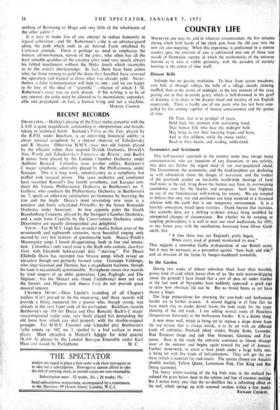In the Garden
During two weeks of almost unbroken black frost (that horrible, greasy kind of cold which kaves clots of ice like stale mutton-dripping about the ground) 1 have found that a row of peas set under cloches in the last week of November have suddenly appeared: a good sign to show how obstinate life can be. But no broad beans as yet have shown a finger.
The large preparations for renewing the rose-beds and herbaceous border are in further process. A second digging in of lime (for we have much clay to render down) leaves the beds ready for the trans- planting of the old stock. 1 am adding several roots of Heuchera (Sanguineum Saturnale) to the herbaceous border. It is a dainty thing.
A new stone wall, which is being set to replace a slope down from the top terrace that is always untidy, is • to be set with six different kinds of aubrietia; Prichard (deep violet), Purple Robe, Lavender, Blue Emperor (large and rich blue blossom), Gloriosa and Fire- queen. Here in the south the aubrietia continues to bloom through most of the summer and begins again toward the end of January. Further stone-work, to cover a bare patch under a large holly tree, is being set with five kinds of helianthemum. They will get the sun there (which is essential for rock-roses). The species chosen are Amabik (double scarlet), Yellow Queen, Lawrenson Pink, Fire King and Ben Dearg (carmine).
The heavy winter-washing of the big fruit trees in the orchard has reduced the grass below them to the texture and hue of coconut matting. But I notice every year that the tar-distillate has a refreshing effect on the turf, which springs up with renewed verdure within a few weeks.
RICIRARD CHURCH.






































 Previous page
Previous page